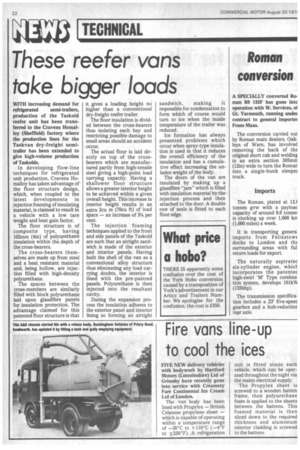AIX
Page 24

If you've noticed an error in this article please click here to report it so we can fix it.
TECHNICAL
These reefer vans
take biqqer loads WITH increasing demand for refrigerated semi-trailers, production of the Task old reefer unit has been transferred to the Cravens Homalloy (Sheffield) factory where the production lines for the Taskvan dry-freight semitrailer has been extended to give high-volume production of Taskolds.
In developing flow-line techniques for refrigerated unit production, Cravens Homalloy has taken advantage of the floor structure design, which, when coupled to the latest developments in _injection foaming of insulating material, is claimed to result in a vehicle with a low tare weight and heat gain factor.
The floor structure is of composite type, having 102mm (4in) of polyurethane insulation within the depth of the cross-bearers.
The cross-bearers themselves are made up from steel and a heat resistant material and, being hollow, are injection filled with high-density polyurethane.
The spaces between the cross-members are similarly filled with block polyurethane laid upon glassfibre panels for insulation protection. The advantage claimed for this patented floor structure is that it gives a loading height no higher than a conventional dry-freight reefer trailer.
The floor insulation is divided between the cross-bearers thus isolating each bay and restricting possible damage to small areas should an accident OCCUr.
The actual floor is laid directly on top of the crossbearers which are manufactured partly from high-tensile steel giving a high-point load carrying capacity. Having a shallower floor structure allows a greater interior height to be achieved within a given overall height. This increase in Interior height results in an extra 2cu m (70cu ft) of load space — an increase of 31/4 per cent.
The injection foaming techniques applied to the front and side panels of the Taskold are such that an airtight sandwich is made of the exterior and interior panels. Having built the shell of the van as a conventional alloy structure thus eliminating any load carrying doubts, the interior is lined with the pre-painted panels. Polyurethane is then injected into the resultant cavity.
During the expansion process the insulation adheres to the exterior panel and interior lining so forming an airtight sandwich, making it impossible for condensation to form which of course would turn to ice when the inside temperature of the trailer was reduced.
Ice formation has always presented problems which occur when spray-type insulation is used in that it reduces the overall efficiency of the insulation and has a cumulative effect increasing the unladen weight of the body.
The doors of the van are insulated by making up a glassfibre "jam" which is filled with insulation material by the injection process and then attached to the door. A double row of seals is fitted to each floor edge.




































































































